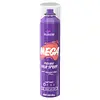What's inside
What's inside
 Benefits
Benefits

 Concerns
Concerns

 Ingredients Side-by-side
Ingredients Side-by-side

Water
Skin ConditioningDimethyl Ether
SolventAcrylates Copolymer
Parfum
MaskingPolyurethane-14
Acrylates/Hydroxyesters Acrylates Copolymer
Aminomethyl Propanol
BufferingAmp-Acrylates Copolymer
Potassium Hydroxide
BufferingPhenoxyethanol
PreservativeBenzyl Alcohol
PerfumingBis-PEG/PPG-16/16 PEG/PPG-16/16 Dimethicone
EmollientCaprylyl Glycol
Emollient1,2-Hexanediol
Skin ConditioningDisodium EDTA
Laureth-4
EmulsifyingCetrimonium Chloride
AntimicrobialEthylhexylglycerin
Skin ConditioningWater, Dimethyl Ether, Acrylates Copolymer, Parfum, Polyurethane-14, Acrylates/Hydroxyesters Acrylates Copolymer, Aminomethyl Propanol, Amp-Acrylates Copolymer, Potassium Hydroxide, Phenoxyethanol, Benzyl Alcohol, Bis-PEG/PPG-16/16 PEG/PPG-16/16 Dimethicone, Caprylyl Glycol, 1,2-Hexanediol, Disodium EDTA, Laureth-4, Cetrimonium Chloride, Ethylhexylglycerin
Ingredients Explained
These ingredients are found in both products.
Ingredients higher up in an ingredient list are typically present in a larger amount.
Acrylates Copolymer is used as a film-forming agent and texture enhancer.
After applied, Acrylates Copolymer forms a thin film cover that helps skin feel more soft. It can help sunscreens become more water-resistant.
It is also used to make a product more thick.
Learn more about Acrylates CopolymerAminomethyl Propanol is used to adjust the pH of products. It is also used as a base to create other organic compounds. Having a balanced pH is important for protecting your skin.
Aminomethyl propanol is safe to use in cosmetics up to 1%. It is soluble in water.
We don't have a description for Amp-Acrylates Copolymer yet.
This ingredient is also known by its brand name, Dymel-A.
It is a colorless gas and often used in aerosols.
Ethylhexylglycerin (we can't pronounce this either) is commonly used as a preservative and skin softener. It is derived from glyceryl.
You might see Ethylhexylglycerin often paired with other preservatives such as phenoxyethanol. Ethylhexylglycerin has been found to increase the effectiveness of these other preservatives.
Parfum is a catch-all term for an ingredient or more that is used to give a scent to products.
Also called "fragrance", this ingredient can be a blend of hundreds of chemicals or plant oils. This means every product with "fragrance" or "parfum" in the ingredients list is a different mixture.
For instance, Habanolide is a proprietary trade name for a specific aroma chemical. When used as a fragrance ingredient in cosmetics, most aroma chemicals fall under the broad labeling category of “FRAGRANCE” or “PARFUM” according to EU and US regulations.
The term 'parfum' or 'fragrance' is not regulated in many countries. In many cases, it is up to the brand to define this term.
For instance, many brands choose to label themselves as "fragrance-free" because they are not using synthetic fragrances. However, their products may still contain ingredients such as essential oils that are considered a fragrance by INCI standards.
One example is Calendula flower extract. Calendula is an essential oil that still imparts a scent or 'fragrance'.
Depending on the blend, the ingredients in the mixture can cause allergies and sensitivities on the skin. Some ingredients that are known EU allergens include linalool and citronellol.
Parfum can also be used to mask or cover an unpleasant scent.
The bottom line is: not all fragrances/parfum/ingredients are created equally. If you are worried about fragrances, we recommend taking a closer look at an ingredient. And of course, we always recommend speaking with a professional.
Learn more about ParfumPhenoxyethanol is a preservative that has germicide, antimicrobial, and aromatic properties. Studies show that phenoxyethanol can prevent microbial growth. By itself, it has a scent that is similar to that of a rose.
It's often used in formulations along with Caprylyl Glycol to preserve the shelf life of products.
We don't have a description for Polyurethane-14 yet.
Water. It's the most common cosmetic ingredient of all. You'll usually see it at the top of ingredient lists, meaning that it makes up the largest part of the product.
So why is it so popular? Water most often acts as a solvent - this means that it helps dissolve other ingredients into the formulation.
You'll also recognize water as that liquid we all need to stay alive. If you see this, drink a glass of water. Stay hydrated!
Learn more about Water